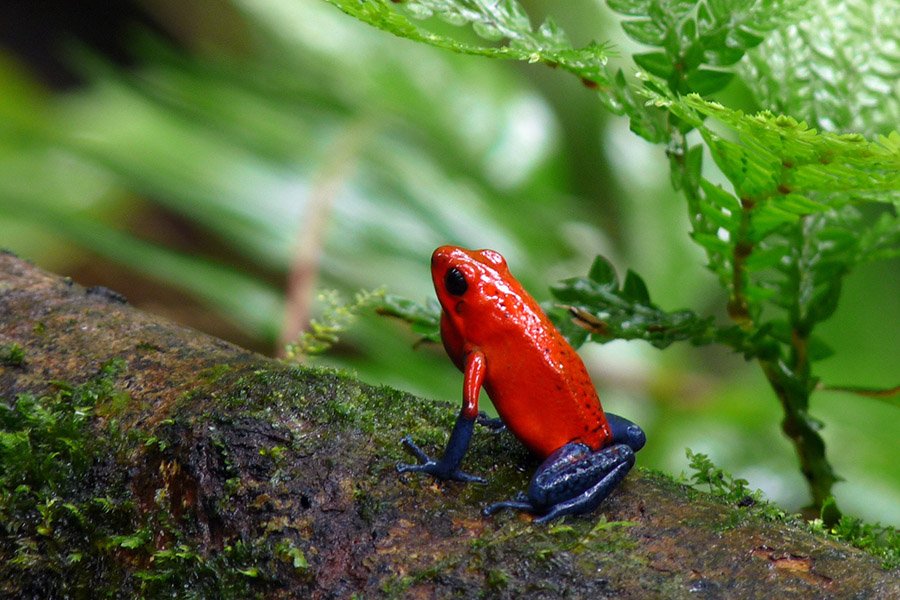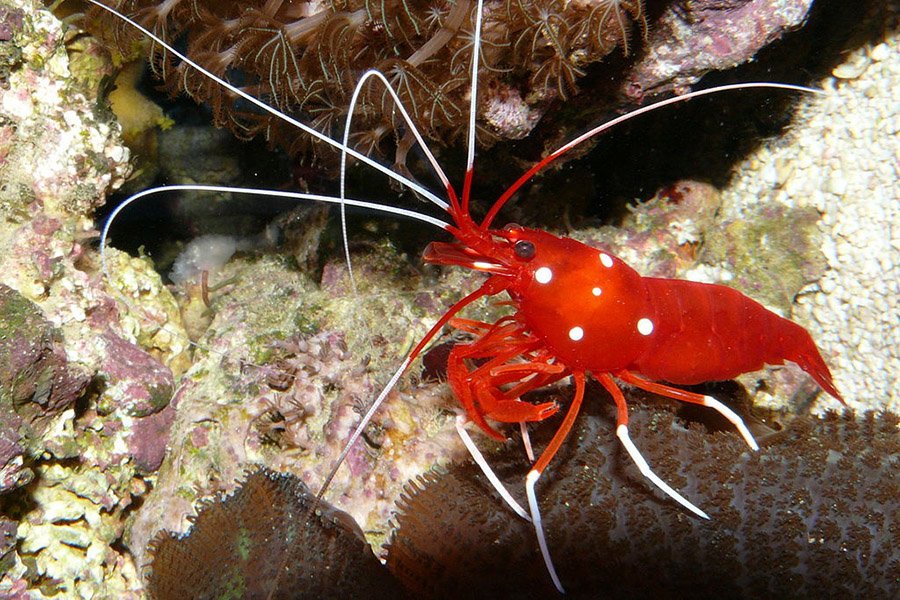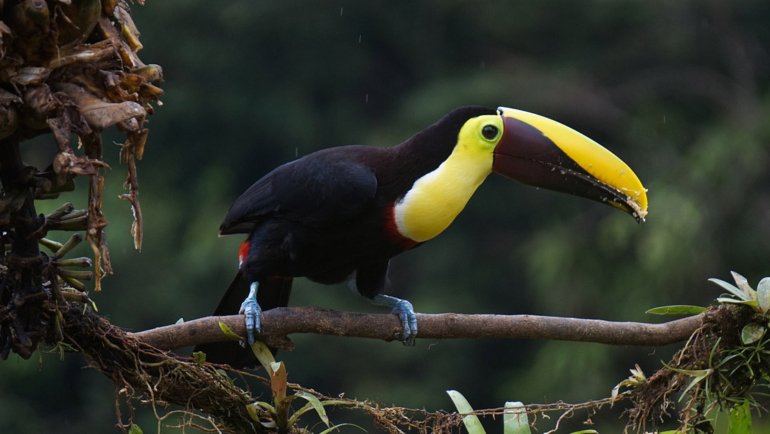Red animals hold a special place in our vision of the natural world. This vivid coloration, present in species across various ecosystems, often plays significant roles in communication, camouflage, or attracting mates.
In this article, we embark on a fascinating journey to explore 12 remarkable red animals, from the iconic Christmas Island Red Crab with its incredible mass migration to the enchanting Strawberry Poison Dart Frog displaying its striking blue jeans, each with its own unique characteristics and captivating stories.
Ready for this journey into the vibrant world of red animals? Let’s get started!
12 Red Animals: Overview
- Northern Cardinal
- Scarlet Ibis
- Ladybug
- Strawberry Poison-Dart Frog
- Female Eclectus Parrot
- Fire Shrimp
- Red Moontail Bullseye
- Red Tanager
- Sockeye Salmon
- Mediterranean Red Sea Star
- Red-Veined Darter
- Christmas Island Red Crab
Red Animals: Pictures and Facts
Northern Cardinal

- Scientific name: Cardinalis cardinalis
- Type of animal: Bird
- Where found: North America
The Northern Cardinal is a vibrant, medium-sized songbird native to North America, ranging from southern Canada through the eastern and central United States, down to Mexico and Central America. This striking bird is known for its brilliant red plumage, distinctive crest, and black facial mask in males, while females exhibit a more subdued reddish-brown color.
Northern Cardinals inhabit woodland edges, gardens, shrublands, and wetlands, where they are often seen perched on low branches or hopping on the ground in search of seeds, fruit, and insects. These birds are non-migratory and are a common sight at bird feeders, where they are particularly fond of sunflower seeds.
The Northern Cardinal is known for its melodic song, which is characterized by a series of whistled notes. Both males and females sing, and their complex vocalizations can convey different meanings, from territorial defense to mate attraction.
Populations of Northern Cardinals are stable, and they are not considered a species of conservation concern. Their adaptability to human-altered environments, such as suburban and urban areas, has contributed to their success and wide distribution.
Scarlet Ibis

- Scientific name: Eudocimus ruber
- Type of animal: Bird
- Where found: South America, Caribbean
The Scarlet Ibis is a striking wading bird known for its brilliant red plumage and slender, curved bill. Native to the tropical regions of South America and the Caribbean, it inhabits a variety of wetland ecosystems, including marshes, swamps, and estuaries.
The remarkable coloration of the Scarlet Ibis is due to the presence of carotenoids in its diet, primarily derived from crustaceans such as shrimp and crabs. This vivid hue serves as an indicator of the bird’s health, with more vibrant individuals being more successful in attracting mates.
Scarlet Ibises are social birds, often found in large flocks, and are known for their synchronized flying patterns. They use their long, curved bills to probe mudflats and shallow waters in search of food, which primarily consists of crustaceans, insects, and small fish.
Though not considered globally threatened, the Scarlet Ibis is listed as “Near Threatened” in some regions due to habitat loss, pollution, and hunting. Conservation efforts, such as habitat protection and the establishment of protected areas, are essential to ensure the survival of this iconic species.
Ladybug

- Scientific name: family Coccinellidae
- Type of animal: Insect
- Where found: Worldwide
Ladybugs, also known as ladybirds or lady beetles, are a group of small, brightly colored beetles belonging to the family Coccinellidae. There are over 6,000 species of ladybugs found worldwide, with approximately 500 species in North America alone.
These tiny insects, usually measuring between 0.8 and 18 millimeters (0.03 to 0.7 inches) in length, are characterized by their round, often red or orange, wing covers adorned with black spots. However, coloration can vary depending on the species. The bright colors and patterns of ladybugs serve as a warning to predators that they are unpalatable, as they produce toxic or foul-tasting chemicals for defense.
Ladybugs are considered beneficial insects because they are natural predators of agricultural pests, such as aphids and scale insects. A single ladybug can consume thousands of aphids in its lifetime, making them an essential ally for gardeners and farmers.
The life cycle of a ladybug consists of four stages: egg, larva, pupa, and adult. The entire life cycle takes about a month to complete, and adult ladybugs can live for up to a year.
Strawberry Poison-Dart Frog

- Scientific name: Oophaga pumilio
- Type of animal: Amphibian
- Where found: Central America
The Strawberry Poison Dart Frog is a small, brilliantly colored amphibian native to Central America, ranging from eastern Nicaragua to northwestern Panama. These diminutive frogs, typically measuring between 17.5 and 22 millimeters (0.7 to 0.9 inches) in length, are known for their striking appearance, with bright red or orange bodies contrasted by blue or black limbs.
A well-known morph of the Strawberry Poison Dart Frog is the “Blue Jeans” Frog, which has a vibrant red body and striking blue legs. The vivid colors of these frogs serve as a warning to predators, as they secrete toxic alkaloids through their skin as a defense mechanism.
These frogs inhabit tropical rainforests and are often found in the leaf litter on the forest floor, where they forage for insects, primarily ants, and mites. Strawberry Poison Dart Frogs are known for their complex reproductive behaviors. Females lay eggs on land, and males later fertilize them. Once the eggs hatch into tadpoles, the female carries them on her back to small pools of water, where they continue to develop.
Despite being listed as a species of “Least Concern” on the IUCN Red List, habitat loss due to deforestation remains a threat to the Strawberry Poison Dart Frog.
Female Eclectus Parrot

- Scientific name: Eclectus spp.
- Type of animal: Bird
- Where found: New Guinea, Solomon Islands, Northern Australia
The Eclectus Parrot is a unique and vibrantly colored parrot native to the rainforests of New Guinea, the Solomon Islands, and northeastern Australia. This medium-sized parrot, measuring around 35 to 42 centimeters (14 to 17 inches) in length, is known for its striking sexual dimorphism.
Male Eclectus Parrots are predominantly bright green, while the females are primarily red with blue or purple accents on their wings and tails. This distinct color difference between the sexes is unusual among parrots and serves as an adaptation to their habitat, with the male’s green plumage providing camouflage in the canopy, and the female’s red plumage blending into the darker understory of the forest.
Eclectus Parrots are primarily fruit-eaters, with their diet consisting of fruits, seeds, nuts, flowers, and leaf buds. They are known for their strong beaks, which they use to crack open hard shells and husks to access their food.
In the wild, these parrots are cavity-nesters, with females guarding the nest while males forage for food. The Eclectus Parrot is not currently considered a threatened species, but habitat loss and the pet trade pose risks to their populations.
Fire Shrimp

- Scientific name: Lysmata debelius
- Type of animal: Crustacean
- Where found: Indo-Pacific Ocean
The Fire Shrimp, also known as the Blood Red Fire Shrimp or the Scarlet Cleaner Shrimp, is a vibrantly colored marine shrimp species found in the waters of the Indo-Pacific, particularly around the coral reefs of Sri Lanka and Indonesia. This eye-catching shrimp typically measures around 5 centimeters (2 inches) in length and is known for its striking bright red body, with white antennae and white spots on its legs and tail.
Both male and female Fire Shrimp exhibit similar red coloration, which allows them to blend in with their coral reef surroundings. These shrimp are omnivorous, feeding on a diet of parasites, dead tissue, and algae. They are also known as cleaner shrimp, providing valuable cleaning services to other marine animals, such as fish, by removing parasites and dead tissue.
Fire Shrimp are nocturnal creatures that spend the daylight hours hiding in crevices and caves, venturing out at night to forage for food. They are popular in the aquarium trade due to their stunning appearance and beneficial cleaning behaviors, but it is important to note that they can be sensitive to water quality and should be kept in appropriate conditions.
Red Moontail Bullseye

- Scientific name: Priacanthus hamrur
- Type of animal: Fish
- Where found: Indo-Pacific Ocean
The Red Moontail Bullseye , also known as the Moontail Bigeye or the Crescent-tail Bigeye, is a species of marine fish native to the tropical and subtropical waters of the Indo-Pacific region, including the Red Sea and the western Pacific Ocean. This striking fish measures up to 45 centimeters (18 inches) in length and is characterized by its large, round body, silvery-red coloration, and big, crescent-shaped tail.
Although both sexes of Red Moontail Bullseye exhibit red coloration, the females tend to be more brightly colored than the males. The species is primarily nocturnal, hiding in caves or under ledges during the day and emerging at night to hunt for their preferred prey, which includes crustaceans, small fish, and cephalopods.
The Red Moontail Bullseye has a unique ability to change its coloration rapidly in response to environmental conditions or threats. This color-changing capability helps the fish blend in with its surroundings, making it less visible to predators.
Red Moontail Bullseyes are not currently considered to be at risk of extinction, but they are subject to commercial and recreational fishing pressure in some areas. Their striking appearance also makes them popular in the aquarium trade, although their large size and specific habitat requirements can make them challenging to keep in captivity.
Summer Tanager

- Scientific name: Piranga rubra
- Type of animal: Bird
- Where found: Southern United Stated to Northern South America
The Summer Tanager is a medium-sized songbird found in the southern United States, Mexico, and Central America, migrating as far south as South America during the winter months. Males of the species are characterized by their bright red plumage, while the females exhibit a more muted yellow-orange coloration, rather than red.
Measuring approximately 16-20 centimeters (6.3-7.9 inches) in length, the Summer Tanager inhabits deciduous forests, especially those with tall trees and dense understory. Its diet primarily consists of insects, particularly bees and wasps, which it catches in mid-air or plucks from tree branches.
The Summer Tanager is known for its melodious song, which consists of a series of clear, musical notes often described as “robin-like”. During the breeding season, the male’s song plays a crucial role in attracting a mate and defending territory.
The Summer Tanager’s population is currently considered to be stable, with an estimated global breeding population of 5.2 million. The species is listed as a species of “Least Concern” by the IUCN Red List due to its large range and relatively stable population numbers.
Sockeye Salmon

- Scientific name: Oncorhynchus nerka
- Type of animal: Fish
- Where found: Northern Pacific Ocean
The Sockeye Salmon, also known as the Red Salmon or Blueback Salmon, is a species of anadromous fish native to the Pacific Ocean and its surrounding rivers in North America and eastern Asia. These fish are known for their striking transformation in color during the spawning season, with males developing a brilliant red body and a green head, while females exhibit a more subdued red hue.
Adult Sockeye Salmon typically measure between 60-84 centimeters (24-33 inches) in length and weigh around 2.3-7 kilograms (5-15 pounds). They primarily feed on zooplankton, but their diet can also include insects and small crustaceans.
Sockeye Salmon are anadromous, meaning they hatch in freshwater, migrate to the ocean to mature, and then return to their natal rivers to spawn and die. This species is of great cultural, economic, and ecological importance, especially to the indigenous peoples of the Pacific Northwest, who have relied on the salmon as a primary food source for thousands of years.
While some Sockeye Salmon populations remain healthy, others have declined due to factors such as habitat degradation, overfishing, and climate change. The IUCN Red List classifies the Sockeye Salmon as “Least Concern” globally, but some regional populations are listed as endangered or threatened.
Mediterranean Red Sea Star

- Scientific name: Echinaster sepositus
- Type of animal: Echinoderm
- Where found: Mediterranean Sea and Eastern Atlantic Ocean
The Mediterranean Red Sea Star is a striking red sea star species found primarily in the Mediterranean Sea, as well as the eastern Atlantic Ocean from the British Isles to Cape Verde. This visually captivating sea star is characterized by its vibrant red or reddish-orange coloration and five elongated, slightly tapering arms.
Measuring up to 25 centimeters (9.8 inches) in diameter, Echinaster sepositus inhabits rocky and sandy bottoms, seagrass beds, and coral reefs at depths ranging from the shoreline to 200 meters (656 feet). This species feeds on various types of organic matter, including dead and decaying organisms, as well as sponges, bryozoans, and detritus.
One interesting feature of the Mediterranean Red Sea Star is its ability to regenerate lost arms and even reproduce asexually through a process called fission, in which the sea star splits in half and regenerates the missing body parts to form two new individuals.
Red-Veined Darter

- Scientific name: Sympetrum fonscolombii
- Type of animal: Insect
- Where found: Eurasia
The Red-Veined Darter is a really stunning dragonfly species belonging to the family Libellulidae. Known for its vibrant red coloration and distinctive red veins on its wings, this dragonfly is commonly found throughout Europe, the Middle East, and Asia, making it one of the most widespread dragonfly species.
Adult Red-Veined Darters measure around 35-45 millimeters (1.4-1.8 inches) in length, with males exhibiting a bright red abdomen and females having a more yellowish-brown abdomen. They are strong fliers, and their habitat includes a wide range of water bodies such as ponds, lakes, slow-moving rivers, and wetlands.
The life cycle of Sympetrum fonscolombii consists of three stages: egg, larva (nymph), and adult. After mating, females lay their eggs in water, where the larvae develop before emerging as adults.
The Red-Veined Darter is currently classified as “Least Concern” on the IUCN Red List due to its wide distribution and large, stable population. However, like many other dragonfly species, it may face threats from habitat loss, pollution, and climate change, highlighting the importance of monitoring and conservation efforts.
Christmas Island Red Crab

- Scientific name: Gecarcoidea natalis
- Type of animal: Crustacean
- Where found: Christmas Island & Cocos Islands
The Christmas Island Red Crab is a remarkable terrestrial crab species native to Christmas Island, an Australian territory in the Indian Ocean. This vibrant red crab is celebrated for its unique and spectacular annual migration, which sees millions of adult crabs moving from the island’s forests to the shoreline for breeding purposes.
Adult red crabs measure approximately 116 millimeters (4.6 inches) in width and are primarily herbivorous, feeding on fallen leaves, fruits, and seedlings. The migration usually takes place during the wet season, between October and December, and is carefully timed with the lunar cycle, ensuring that the release of eggs into the ocean coincides with the turning tides.
The Christmas Island Red Crab is a keystone species, playing a critical role in shaping the island’s ecosystem. It helps to recycle nutrients and influences the distribution and abundance of other organisms, including plants and other invertebrates.
The species faces a significant threat from the invasive yellow crazy ant (Anoplolepis gracilipes), which has been responsible for the decline of red crab populations in certain areas of the island.





